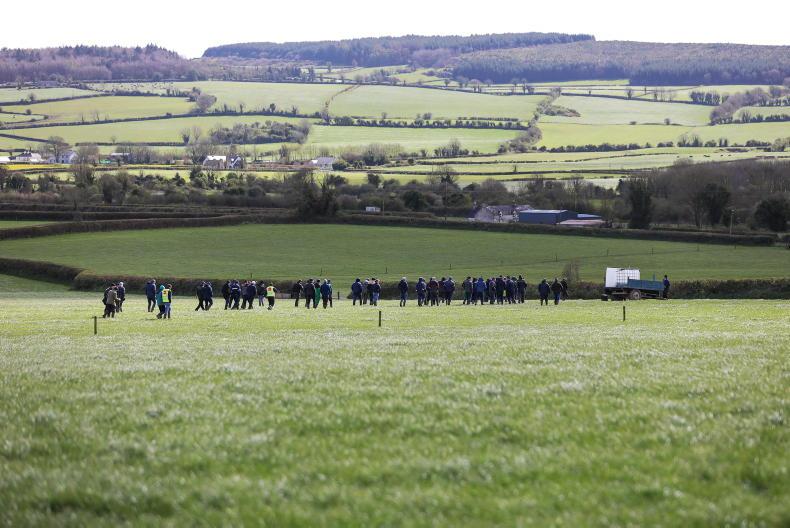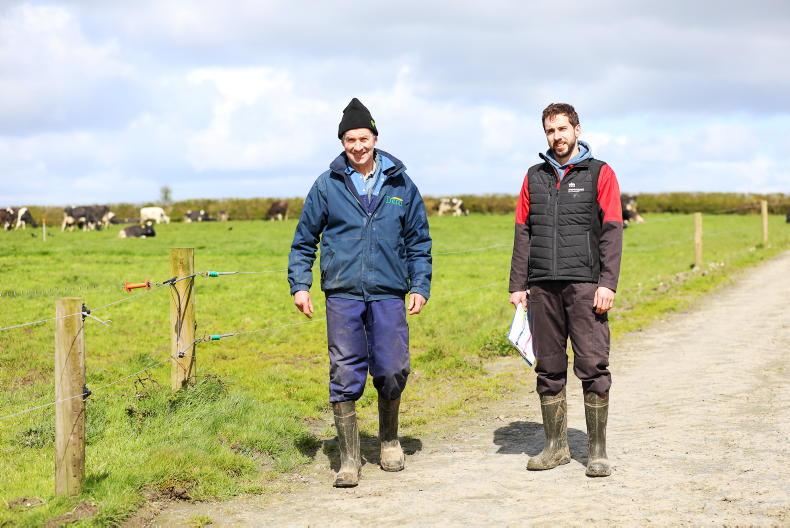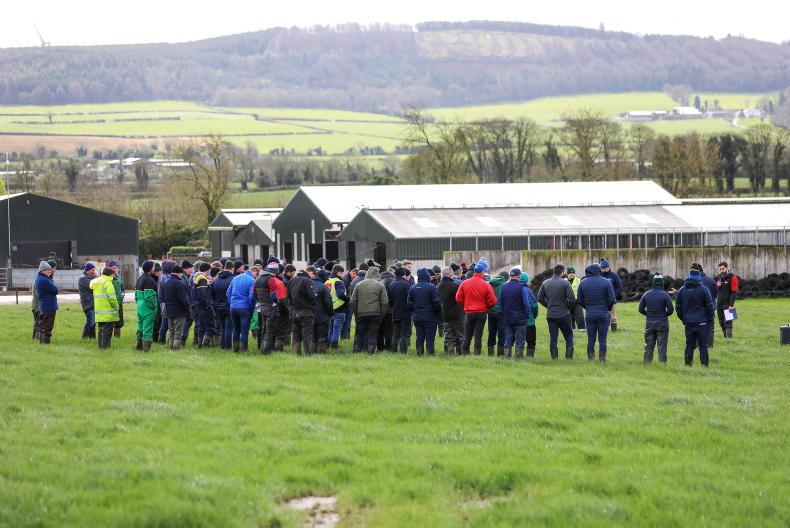Eileen, Denis and Paul Bowden are milking 140 cows and rearing all replacements on a 79ha farm near Urlingford in Co Kilkenny. Teagasc held a farm walk there last week, to discuss current grassland management in the wet weather and ways to get clover established.
There was a good turnout of farmers from the locality – they came for advice and they got plenty of it. First up was fertiliser. A lot of farmers have no fertiliser spread to date, which is unheard of for the middle of April, but sensible given ground conditions and weather.
John Maher from Teagasc said that farmers have three options when it comes to fertiliser. On fields that got no fertiliser to date and are destined for grazing, he said that they should be spread with 35 to 40 units of N/acre as soon as conditions allow. He said that fields that got nitrogen, but did get slurry three to four weeks ago can get a bit less nitrogen now, at around 30 units/acre.
On silage ground, John said that if the P and K levels are good, then the slurry can be spread after the crop is cut, as he said the grass cover is likely to be too strong for slurry now. He said that if the P and K levels are low, then compound fertiliser will be needed now to grow the crop and boost yields.
Spreading three bags/acre of 0:7:30 would have been the advice earlier in the year, but he cautioned against late and high applications of potash, referencing 2018 when fertiliser was spread late and farmers had more milk fever problems in spring 2019 as a result of high K levels in the silage.
On nitrogen, John said that farmers should be targeting a cutting date for first-cut silage of between 20 and 25 May and that nitrogen is used up at a rate of two units/acre per day.
“The mistake farmers have made in the past is to chase a big yield for first cut which results in later cutting, a white stem at the base and then a far later cut and lower yields in the second cut, whereas overall silage yields are higher when the first cut is taken early,” he said.

A large gathering of farmers took part in the Teagasc Spring Clover Walk on the dairy farm of Paul Bowden, Ballynascarry, Graine, Urlingford, Co Kilkenny. Topics discussed included current grazing and fertiliser application in light of difficult spring conditions, along with the establishment of white clover and fertiliser application strategies to maintain clover and pasture production. \ Odhran Ducie
Damaged paddocks
Paul Bowden explained that the cows were housed by night for most of March and up to last week as ground conditions were just too challenging. He got 87% of the farm grazed before switching into the second round covers, which are at 1,300 to 1,400kg DM/ha. A total of about 10 grazings were missed in the spring, so Paul has fared much better than other farmers. It’s a well set-up farm, with excellent roadways, dry land, but, importantly, they have a desire to get grass into cows.
Having said that, damage was done in places during the first rotation and the challenge is to avoid damaging land twice. With a grass surplus building, Paul reckons he would prefer to graze damaged land rather than close it up for silage, because he says this area needs to tiller to fill in the gaps and it won’t tiller if it’s growing silage. It will get additional P and K to help the soil repair.
On silage stocks, Paul is okay, with enough round bales to see them through this spring. Interestingly, he uses the pit silage first and then uses bales at this time of year, which he says works better as there is less wastage on the pit face and the silage pit is always empty for the first cut. He says that the bales are more flexible this time of year. Cows have been getting three round bales per night and usually have an appetite for grass by the morning. They have been on 5kg of meal per day, but Paul says this will drop once conditions improve.
When asked if he’d be interested in buying alternative forages, such as maize or beet, to rebuild silage stocks, Paul said he’d rather stick to what he knows and reckons he will be able to build up stocks fairly easily as the overall stocking rate is relatively low. The farm grew over 13t DM/ha last year, with the herd of Holstein Friesian cows delivering 520kg MS/cow from 750kg of meal.

Denis and Paul Bowden at the Teagasc Spring Clover Walk, on their dairy farm at Ballynascarry, Graine, Urlingford
Eileen, Denis and Paul Bowden are milking 140 cows and rearing all replacements on a 79ha farm near Urlingford in Co Kilkenny. Teagasc held a farm walk there last week, to discuss current grassland management in the wet weather and ways to get clover established.
There was a good turnout of farmers from the locality – they came for advice and they got plenty of it. First up was fertiliser. A lot of farmers have no fertiliser spread to date, which is unheard of for the middle of April, but sensible given ground conditions and weather.
John Maher from Teagasc said that farmers have three options when it comes to fertiliser. On fields that got no fertiliser to date and are destined for grazing, he said that they should be spread with 35 to 40 units of N/acre as soon as conditions allow. He said that fields that got nitrogen, but did get slurry three to four weeks ago can get a bit less nitrogen now, at around 30 units/acre.
On silage ground, John said that if the P and K levels are good, then the slurry can be spread after the crop is cut, as he said the grass cover is likely to be too strong for slurry now. He said that if the P and K levels are low, then compound fertiliser will be needed now to grow the crop and boost yields.
Spreading three bags/acre of 0:7:30 would have been the advice earlier in the year, but he cautioned against late and high applications of potash, referencing 2018 when fertiliser was spread late and farmers had more milk fever problems in spring 2019 as a result of high K levels in the silage.
On nitrogen, John said that farmers should be targeting a cutting date for first-cut silage of between 20 and 25 May and that nitrogen is used up at a rate of two units/acre per day.
“The mistake farmers have made in the past is to chase a big yield for first cut which results in later cutting, a white stem at the base and then a far later cut and lower yields in the second cut, whereas overall silage yields are higher when the first cut is taken early,” he said.

A large gathering of farmers took part in the Teagasc Spring Clover Walk on the dairy farm of Paul Bowden, Ballynascarry, Graine, Urlingford, Co Kilkenny. Topics discussed included current grazing and fertiliser application in light of difficult spring conditions, along with the establishment of white clover and fertiliser application strategies to maintain clover and pasture production. \ Odhran Ducie
Damaged paddocks
Paul Bowden explained that the cows were housed by night for most of March and up to last week as ground conditions were just too challenging. He got 87% of the farm grazed before switching into the second round covers, which are at 1,300 to 1,400kg DM/ha. A total of about 10 grazings were missed in the spring, so Paul has fared much better than other farmers. It’s a well set-up farm, with excellent roadways, dry land, but, importantly, they have a desire to get grass into cows.
Having said that, damage was done in places during the first rotation and the challenge is to avoid damaging land twice. With a grass surplus building, Paul reckons he would prefer to graze damaged land rather than close it up for silage, because he says this area needs to tiller to fill in the gaps and it won’t tiller if it’s growing silage. It will get additional P and K to help the soil repair.
On silage stocks, Paul is okay, with enough round bales to see them through this spring. Interestingly, he uses the pit silage first and then uses bales at this time of year, which he says works better as there is less wastage on the pit face and the silage pit is always empty for the first cut. He says that the bales are more flexible this time of year. Cows have been getting three round bales per night and usually have an appetite for grass by the morning. They have been on 5kg of meal per day, but Paul says this will drop once conditions improve.
When asked if he’d be interested in buying alternative forages, such as maize or beet, to rebuild silage stocks, Paul said he’d rather stick to what he knows and reckons he will be able to build up stocks fairly easily as the overall stocking rate is relatively low. The farm grew over 13t DM/ha last year, with the herd of Holstein Friesian cows delivering 520kg MS/cow from 750kg of meal.

Denis and Paul Bowden at the Teagasc Spring Clover Walk, on their dairy farm at Ballynascarry, Graine, Urlingford








 This is a subscriber-only article
This is a subscriber-only article











SHARING OPTIONS: